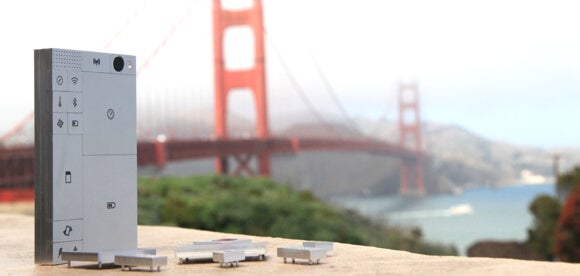Motorola’s been Googlified. It didn’t take long. The firm’s advanced technology projects team (ATAP) is perhaps the most obvious symptom. ATAP is to Motorola what Google X is to Google. The team says they’re pirates who like “epic shit,” and like their parent company, they’re suitably obsessed with open source.
But while Google pushes open source software platforms like Android, Motorola’s ATAP is busy working on open source hardware platforms for smartphones. It’s their way of tackling the rapid cycles of obsolescence today’s devices undergo.
Called Project Ara and a year in the making, the dream is to provide a single universally compatible base (or endoskeleton) onto which every other component, from battery to camera, attaches. These components may be manufactured by a giant corporation or a maker on a shoestring budget—users will be free to choose.
It’s an interesting concept, but it isn’t solely Motorola’s. Some great ideas materialize in multiple brains simultaneously. Dave Hakkens is a designer based in the Netherland whose project, Phonebloks, proposes an open source, modular approach to devices like Project Ara. And it’s gone completely viral.
On the Phonebloks website, Hakkens writes, “A phone only lasts a couple of years before it breaks or becomes obsolete. Although it’s often just one part that killed it, we throw everything away because it’s almost impossible to repair or upgrade.”
Hakkens hopes modular devices based on a platform like Phonebloks will reduce e-waste (growing junk heaps of discarded devices) in the future. It would also make updating, repairing, and customizing devices much easier.
Let’s say you drop your phone and crack the screen, but the rest of the phone still works. Fine. Buy a new screen, pop off the old one, and click the new one into place. Or maybe your phone is getting sluggish. Simply order a new processor to replace the old one.
Modular devices would also be customizable. Depending on how you use your phone, you might forego a camera for a bigger battery. Someone else might use cloud storage and, therefore, prefer a bigger processor to storage on their device.
Initially, Phonebloks was hoping to drum up a community of 500 supporters. Instead, they got close to a million, their YouTube pitch clocked over 17 million views, and they attracted a high-powered partner—Motorola.
The two groups—one a 40-year phone veteran owned by one of the biggest tech companies in the world, the other a plucky team of two—recently decided to collaborate.
Motorola said, “Turns out we share a common vision: to develop a phone platform that is modular, open, customizable, and made for the entire world. We’ve done deep technical work. Dave created a community. The power of open [source] requires both.”
The ATAP team will involve hardware developers over the next few months and offer a module developer’s kit (MDK) this winter. Throughout the process they’ll ping the community for ideas and critiques.
Whether the idea gets wings once released into the wild remains to be seen.
Modular devices might appeal to those who prefer Android to iOS—and they might face a similar trade off. Open source offers more freedom and customizability, but it also tends to be a touch messier. Meanwhile, a closed ecosystem with the right designers can provide polish and panache.
That said, it’d be marvelous to buy a device once, improve it as often as you like, and perhaps permanently ditch contracts for subsidized phone upgrades.
Image Credit: Phonebloks




